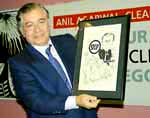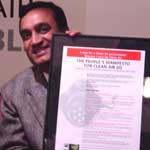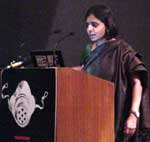People's Manifesto
December 3, 2002
Former Chief Justice B N Kirpal unveils Anil Agarwal
Clean Air Model |
The Model takes stock of the current measures to combat
vehicular pollution. Thanks to the Supreme Court, pollution levels have stabilised. But
this is not enough.
The Model then charts an alternative course, showing that
vehicular pollution can be purposefully tackled only if some hard decisions are taken.
Today’s stability may get completely undone if the
present lassitude continues. To achieve the Clean Air goal — a people’s right, a
demand the model insists is met — the government cannot shy away from hard decisions.
This is what precisely might happen, if, for instance, the extremely weak Auto Fuel Policy
is allowed to determine the official roadmap. The Model warns, therefore, of the return of
tailpipery (a term Anil Agarwal coined in 1996 to denote official and institutional apathy
to vehicular pollution), but also shows the way ahead, and out, of smog.
 |
| B N Kirpal recieving token of appreciation from CSE for
his unwavering support |
Click
to enlarge |
NEW DELHI: The Anil Agarwal Clean Air Model developed by
the Centre for Science and Environment (CSE) as a policy tool laid bare how daunting the
task had been to stabilize pollution levels in the capital despite the growing numbers of
vehicles. If the people of Delhi hadn’t found support in the Supreme Court of India
the air in Delhi would have been many time worse. Delhi would have been choking on 38
percent more particulates, which kill one person per hour in Delhi alone.
In a public meeting organized by CSE at the WWF
auditorium in New Delhi, the former Chief Justice of India Justice B N Kirpal unveiled the
Clean Air Model, originally conceived by the founder director of CSE, Anil Agarwal. Based
on the results of the model CSE has developed a People’s Manifesto to chart the
future course of action to clean up the air of Delhi. The meet was attended by Ajay Maken,
Transport Minister, Delhi, and Bhure Lal, chairperson of the statutory panel Environment
Pollution (Prevention and Control) Authority who has been advising the Supreme Court on
vehicular pollution. CSE director Sunita Narain discussed the key findings of the Clean
Air model and set the future agenda for action. Anumita Roychowdhury, coordinator of
CSE’s Right to Clean Air campaign, outlined CSE’s successful campaign in
marshalling public opinion.
 |
| CSE presented Delhi Transport Minister Ajay Maken with
the People's Manifesto |
Click
to enlarge |
Ever since the Supreme Court had swung into action and
hammered in a series of significant rulings, smog has lifted visibly in the Capital.
Above-15-year-old commercial vehicles got off the road, fuel sulphur was lowered to 500
ppm, petrol benzene cut to 1 percent, public transport moved to CNG, and Euro II emissions
standards were advanced. The Clean Air Model shows that with the help of these actions the
runaway pollution level has been arrested in the city that has more vehicles than other
metros. The model is based on the simple principle that the emissions from a vehicle
depend on the type of technology, quality of fuel, the numbers of kilometres it runs
everyday, and how the engine of the vehicles deteriorate over time.
The stark results from the model also expose that if the
city is left at the mercy of the official road map – the Auto Fuel Policy –
slated by the committee headed by the R A Mashelkar, director general, Council of
Scientific and Industrial Research, it will not make any difference to the city’s
air. The committee does not even consider vehicular pollution to be a problem. By its own
admission the committee does not even expect pollution to grow if no action is taken and
traffic load increases by 50 per cent. It has played around with facts and figures to
state that there is no clear link between health and air pollution, contribution from
vehicles to pollution is not even significant - So why this aggressive action?
CSE’s Clean Air Model trashes this claim and shows
that with the help from the Court we have only stabilized pollution; but this battle can
be won not by just catching up, but by leaping ahead with hard and fast decisions. The
computer-based Clean Air Model runs through all possible policy interventions, technical
and administrative, to assess the possible impact on the air quality as a result of these
actions. It shows that if people have their way to chart the best course of action on
clean vehicles technology, Delhi can avoid 81 per cent of additional load of particulates
by 2015. But even with the most ambitious action plan the city would still be far off the
clean air targets by 2015.
 |
| CSE Director Sunita Narain: 'It's time India leapfroged
to stricter emission norms' |
Click
to enlarge |
CSE therefore presents the People’s Manifesto for
clean air for aggressive action.
Despite the odds, implementing the CNG programme was
easy. Getting a more aggressive and a composite roadmap off the ground would require far
stronger political will and popular support.
|

